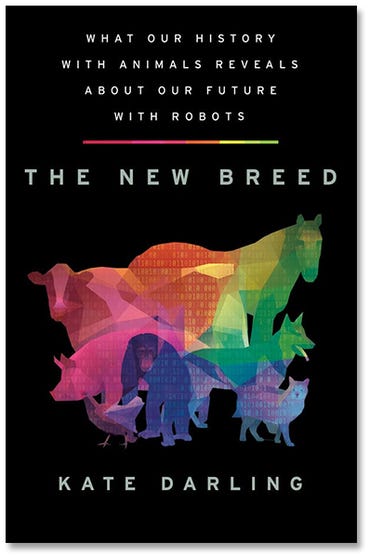
The New Breed: What Our History with Animals Reveals about Our Future with Robots • By Kate Darling • MacMillan Publishers • 336 pages • ISBN: 9781250296108 • $29.99 / £20
Would you play fetch with your robot dog? And if so, why? My guess is that it’s a thing you’d do while the robot pet was new, and then maybe to show your friends and your friends’ kids, and then maybe a few times when you’re bored. But otherwise, what’s the benefit? A mechanical pet doesn’t need exercise and can’t respond emotionally to the attention. So playing fetch with it is purely for you. Fun while it’s still a novelty, but after that…?
As MIT robotics researcher Kate Darling shows in The New Breed: What Our History with Animals Reveals about Our Future with Robots, this is not a trivial question. Robots don’t have emotions, but we do, and experience has already shown that we can bond closely even with inanimate objects despite knowing they can’t really return the attachment. As robots increasingly become part of our lives as devices, pets, assistants, and partners, how we adapt to their presence matters.
Darling isn’t interested in the extreme questions that populate the media, but are really too speculative or far-off in comparison to the problems posed by the near-present. Worse, when we cast robots as taking our jobs, the resulting fear and resentment prevent us from considering the better option within our grasp: harnessing robots as partners, as we did with animals before.
SEE: Facebook: Here comes the AI of the Metaverse
Think oxen and farmers, or humans and pack animals like camels and donkeys. Throughout the history of our interactions with animals, they have helped us do things we couldn’t accomplish on our own — and all without being judged on whether their intelligence matched our own. Making robots ‘like us’, Darling writes, is silly. We already have humans: instead, we should be thinking about how robots can complement us.
Animal rights, and wrongs
In between, Darling explores some of the stranger parts of our history with animals. In medieval Europe, animals were frequently tried in court for sins such as attacking children (pigs) or destroying crops (rats and insects, but especially weevils, which featured in one case that lasted 41 years). As late as 1916, in Tennessee, an elephant was tried for attacking her handler. Darling meticulously inserts trigger warnings on some of these chapters. She then goes on to consider our history of pets and companion animals, before moving on to consider robot rights in the light of the evolution of animal rights.
Over and over, Darling asks why we frame robots as replacements for human friends, carers or workers. We worry about the loneliness of older relatives alone in a room with a robot, but don’t blink when a care home acquires a couple of goats. Yet Darling reminds us that when pets became popular, psychologists fretted that human-animal relationships were unhealthy, too. That said, Darling recognises that robots, like other digital devices, are built by companies with their own agendas, and that the potential for privacy invasion and manipulation is significantly different.
Most important, Darling reminds us to ignore the inevitability narrative that governs so many discussions of technology. We have choices about how this goes.
RECENT AND RELATED CONTENT
3 ways robots won in 2021
It’s time for the machines to take over
Robots to clean NYC skyscrapers
Robot taxi boats take to the water in Amsterdam
Robots for kids: Best STEM kits and other tech gifts for hackers of all ages
Read more book reviews
Credit: Source link




















